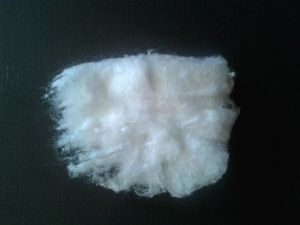Cellulose
 Cotton, the most common form of cellulose.
| |
| Properties | |
|---|---|
| (C6H10O5)n (n=300-10,000) | |
| Molar mass | 168.15·n g/mol |
| Appearance | White solid |
| Odor | Odorless |
| Density | 1.5 g/cm3 |
| Melting point | 260–270 °C (500–518 °F; 533–543 K) decomposes |
| Boiling point | Decomposes |
| Insoluble | |
| Solubility | Reacts with halogens, conc. nitric acid, sulfuric acid Soluble in Schweizer's reagent Insoluble in organic solvents |
| Vapor pressure | ~0 mmHg |
| Thermochemistry | |
| Std enthalpy of
formation (ΔfH |
−963 kJ/mol |
| Hazards | |
| Safety data sheet | Merck (microcrystalline) |
| Related compounds | |
| Related compounds
|
Dextrin Starch |
| Except where otherwise noted, data are given for materials in their standard state (at 25 °C [77 °F], 100 kPa). | |
| Infobox references | |
Cellulose is an organic compound, a polysaccharide with the general chemical formula (C6H10O5)n, where n is the number of D-glucose units. The value of n depends on the type of cellulose: for wood-derived, it reaches between 300 and 1700, while for cotton, 800 to 10,000.
Contents
Properties
Chemical
Cellulose will burn in open air, when ignited.
Cellulose can be nitrated with a nitrating mixture to yield nitrocellulose.
Physical
Cellulose is an odorless white solid, insoluble in all common solvents, but will dissolve in Schweizer's reagent, a property exploited in industry. It decomposes when heated to its melting point (260–270 °C).
Availability
Cellulose is available in too many forms to be enumerated here. The most common form of cellulose is the classic cotton padding, which is nearly pure (99%) cellulose. This is sold in almost all stores, and it's dirt cheap. However, some cotton may have perfume or other additives, while other "cottons" may be other fibers. Always read the label.
Most electronic cigarette stores will also sell pure cellulose as cotton wicks, used in atomizers. The most common form is the Japanese organic cotton.
Hemp fibers also have a high percentage of cellulose, between 70-78%, while the rest is 15-20% hemicelluloses, 3-3.3% lignin, 1-2.5% pectic substances, 2% water-soluble matter, and traces of natural pigments.
Although paper contains cellulose, it is NOT pure cellulose, and in fact also contains lignin, pigments, various salts, as well as other other additives.
Cellulose insulation materials are also another source. However, cellulose insulation tends to contain additives and boric acid/borax, and is generally not useful in reactions, but it can be a cheap excellent heat and sound insulator.
Microcellulose fibers are sold by various chemical suppliers.
Preparation
Cellulose can be extracted from wood pulp, paper or any other plant material with various methods.
One can also grow cotton plants and collect the resulting cotton fibers.
Projects
- Make paper
- Make rayon
- Make cellulose acetate
- Make nitrocellulose
- Make microcrystalline cellulose
- Cellulose insulation
Handling
Safety
Cellulose has low to none toxicity and it's generally considered a safe material.
Storage
Cellulose should be stored in closed bottles, away from moisture or acids.
Disposal
Cellulose is non-toxic and can be burned or dumped in trash.